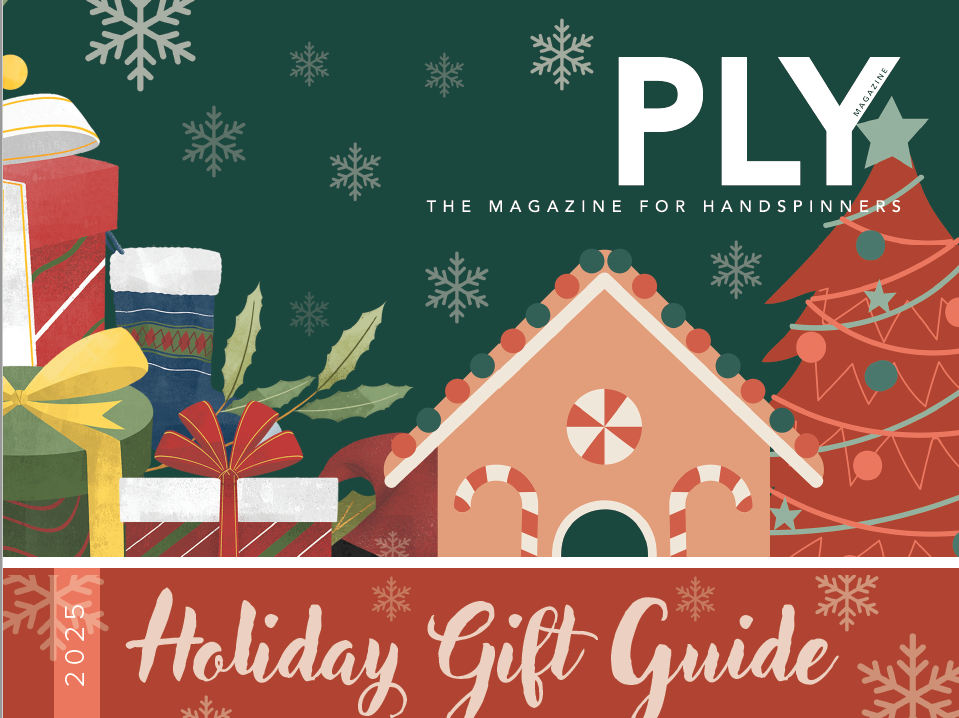Search for articles in published issues of PLY Magazine. You can search by any or all of the options: author, word(s) in the title, word(s) in the description, issue topic, or article topics. Note that the article topics search will show results of articles that fit ALL of the selected topics.
Click the article title to open the single entry for that article (which makes it easier to read the description). Click the issue topic to find that issue in the PLY shop.
Total Records Found: 1381, showing 25 per page
Too often, silken blends are disparaged for being difficult to spin, when in reality they just need a more purposeful touch. Learn how to spin from the fold and expand the light-reflecting qualities of your shinier spins.
Preparing and spinning a Polwarth/silk combed top from the fold for a warm, lofty yarn.
Crochet pattern for a lace cowl in worsted weight yarn.
The Russian spindle is commonly known as a supported spindle in English sources. What is “genuine” Russian spinning?
A profile of the Old Town Fiber Arts Guild of San Diego, CA, USA, which focuses on spinning for the recreation of traditional colcha embroidery.
What’s the difference between worsted prep/woolen draft and woolen prep/worsted draft when it comes to using the yarns? This article investigates the effects on consistency, shrinkage, knitted stitch definition, and wear.
Do you ever get the urge to go against everything you’ve learned, just to see what happens? Follow along with this adventure in doing just that.
Sometimes it’s more interesting to spin a fleece and weave it without quite knowing how it will turn out. Follow this spinner/weaver’s process, and get some tips on weaving with handspun wool along the way!
PLY readers give you their ways of getting and staying organized and keeping samples straight.
Is it useful to use the term “semi-” for yarns with mixed preparation and drafting methods? Three spinners share their opinions on terminology and categorization.
Do you have a double drive or flyer-led (Scotch tension) wheel, but want to experiment with bobbin-led spinning? You may be able to convert your existing wheel!
Did you know your bobbin-led drive setup can double as a bobbin winder? This article shows you how to do it.
What is a “bobbin-led” wheel? How does it work and how do you spin on it?
This article addresses both the strengths and weaknesses of bobbin-led wheels – and why you should look at these wheels as offering opportunities to experiment.
A bobbin-led wheel can feel like a bully if you’re not used to how “pully” it is. This article encourages open-minded exploration in pursuit of a more ergonomic (and pleasurable) spinning experience.
This article investigates best practices for spinning fine yarns on any wheel, not just bobbin-led.
Want to broaden your fiber experience? This article offers advice on controlling tension and twist when spinning everything from plant fibers to luxury wools.
The brake band is a crucial component of the bobbin-led wheel. Changing its material can noticeably alter the take-up behavior of your wheel, as shown in this experimental article.
A newcomer to bobbin-led spinning walks through the challenges and successes she faced in creating a yarn for shawl knitting (in an accompanying article).
The pattern for a triangular shawl with garter stitch tab, complex lace, and edge eyelets in 2-ply merino/silk yarn.
Why is the bobbin-led drive system also called “Irish tension”? This article investigates the potential origins of the term in spinning history.
This article profiles Ashford, Babe’s Fiber Garden, Heavenly Handspinning, Henkys, and Louet – all makers of bobbin-led wheels – and why SpinOlution ceased production on their own model.
The humble spindle is one of humanity’s earliest textile tools. This article follows its development from Neolithic stick to complex modern machines.
This article meditates on the connection between crafter and tool.

